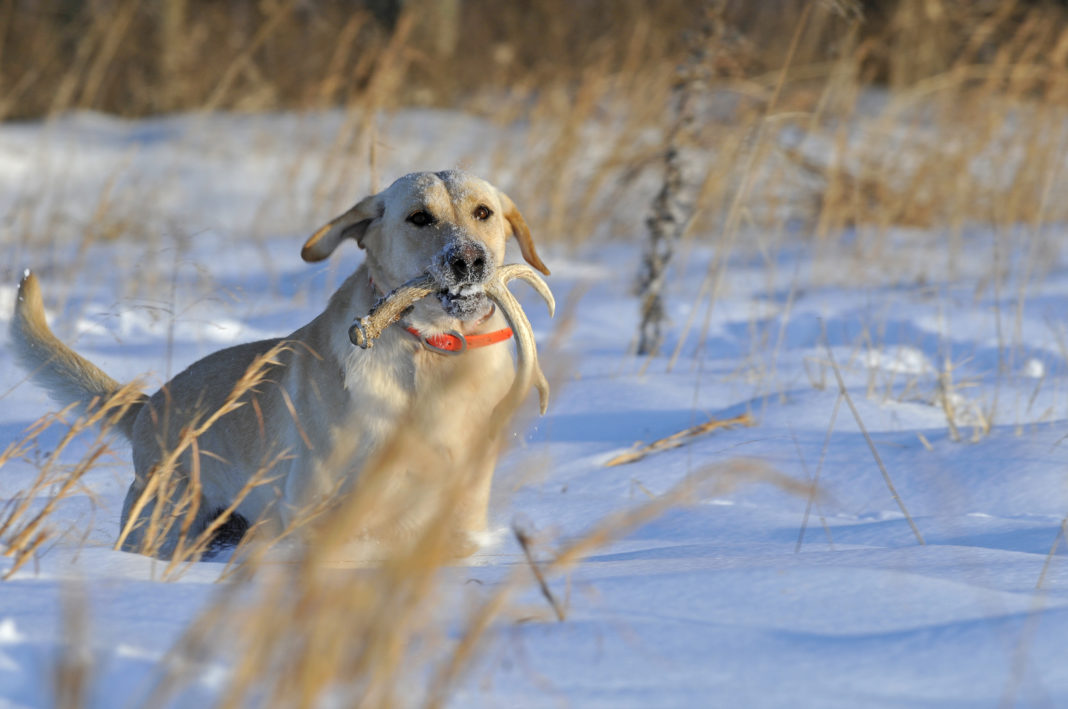Walking through the woods, looking for the glistening of a tine, I wonder whether I will spot the entire rack of my next trophy. After searching every known deer hangout, I finally see what I’m looking for. In the wide open, near a fence crossing, is an antler. But this time, it’s not connected to a deer. Instead, it lies on the ground, jarred loose from the buck’s head, probably as a result of jumping the fence and landing hard.
Shed hunting is becoming more popular every year, especially the sport of hunting sheds with dogs. Because sheds can be harder to find than most hunters think, training dogs to find sheds is ever more commonplace. Advice on training a range of breeds to locate sheds, professional trainers, and pre-trained dogs can be found online.
Hunting antler sheds with a dog is very similar to hunting pheasant or quail with a close-working bird dog. The dog quarters 25 to 75 yards in front of the hunter, downwind. When the dog hits the scent of the antler, it will go to the find and bring it back to its handler.
Before purchasing a dog, it’s important to research breeders and their bloodlines. Because of the demand for Labs, care must be taken to get a pup from a reputable dealer. High demand always seems to cause the breed quality to show defects. It’s not unusual to find dogs with hip dysphasia or mental problems. It’s always wise to get a clean bill of health first, along with a guarantee of healthy hips and elbows.
There are some advantages to purchasing a puppy instead of an adult dog. The first reason is that this is a very important bonding period in a dog’s life. Those first few months set the pattern for the pooch’s lifetime. A pup needs to be nurtured and his confidence built, to help him be able to go out and hunt on his own. When a dog hunts for antlers, he must be able to go about his work totally independent of human support. Of course, you will take him to the woods or the field, but ultimately he will have to go into areas that his senses tell him to hunt. If you have a properly trained dog, his nose will find antlers even in a harvested cornfield. In corn stubble, it’s almost impossible for the human eye to see an antler.
After you have decided whether to purchase a puppy or an adult dog that meets all the requirements, you have to decide whether to get a male or a female. Both have pros and cons, but many people have a personal preference. On a reasonable level, you can make a case for selecting either. Males normally develop a little slower and can be a bit headstrong, but they can be less trouble in the field. Females, on the other hand, while quick to pick up the training, can be soft and cannot be forced into training too strongly. Females also have a way of coming into season at just about the same time that you want to go on a hunt with your friend that just happens to have a male dog.
There is no certain breed of dog needed for this, but Labs are the preferred choice. Training your dog begins with a simple game of fetch using an antler. This will help him distinguish between an antler and a favorite toy when he gets to the woods or field. When using an antler for fetch, be sure to grind down the tips of the antlers so the dog does not injure itself with the new, awkward toy. It will not take long before your dog is able to find his own antler in the woods. Any dog that’s capable of retrieving a bone at home during a game of fetch will likely be able to come back with a shed when in the woods.
The timing of antler shedding varies from region to region, and such local factors as weather and nutrition can cause annual variability on a given site. For most areas of the country, March and April are peak months, though some hunters will find sheds earlier and later. Looking too soon or too late means wasted effort.
Because bucks lose up to 30 percent of their body weight during the rut, food — and eating as much of it as they can — is about the only thing on their minds. If you know the location of a food source with nearby thick cover and a south-facing hillside for warmth, chances are this is where the deer will choose to feed.
A buck’s antlers are barely hanging on during the final stages of shedding; anywhere that will help jar the antlers off is another good place to look. Follow trails that lead to fences and creek crossings. Jumping these obstacles is often enough to jar the antlers to the ground.
Tell us what you think in the comments section below.
Photo: antlerdogs.com



















![The Best Deer Camp Chili [VIDEO] Deer Chili Ingredients, Tomatoes, Chili Spices](/wp-content/uploads/2015/10/Deer-Chili-Deer-Camp-Recipe-218x150.jpg)
![How to Call Elk Early in the Season [VIDEO]](/wp-content/uploads/2016/08/byers003-218x150.jpg)




![Idiots Disturb Hunter: How Would You Have Handled It? [VIDEO]](/wp-content/uploads/2015/10/DSC00110-e1474487693878-100x70.jpg)
![Albino Buck Shocked to Shed His Antlers [VIDEO]](/wp-content/uploads/2015/10/AlbinoDeer-100x70.jpg)